We took one boat to two different locations and spent a whole lot of time to put together a comprehensive fuel and performance data comparison on nine different 90hp outboards. The results proved both interesting and predictable.
It was back in 1996 that we last ran a head-to-head comparison on 90hp outboards and at that time had only five, comprising four 2-strokes and one 4-stroke. All four 2-strokes were 3-cyl. carburetted engines as there was no such thing as a direct injected 2 stroke at that time. Well, times have certainly changed and today we are presented with ten 90hp offerings, although one, the Honda 90, has just been superseded by the Honda 100hp. The line-up has certainly changed, and now comprises a trio of 4 strokes, four 2-strokes and two direct injected 2-stroke engines. I realise that only makes nine, but the tenth, the Tohatsu 90 TLDI, wasn’t available for our test. The tests were performed with just two people aboard a new Huntsman 525 CSB500, using a Lowrance fuel flow system and GPS. In the case of some of the engines, such as Mercury, we also cross checked with their own SmartCraft gauges in an effort to ensure that our figures were as accurate as possible.
Fuel was drawn from a 25-litre tote tank and most engines were evaluated over a period of 30 minutes, with various runs depending on the tide. All tests were performed several times to ensure accuracy and repeatability.
The figures recorded are as per the boat and engine/propeller set-up on the day and will vary depending on what boat the same engine package is bolted onto. However, the speed and fuel figures will give an idea of the efficiency and performance of each engine. Changing propellers and engine heights can have a huge bearing on results, as will a much heavier or lighter boat. Special thanks to the guys at CSB Huntsman and to Trevor Hart from Hart Marine, Whakatane, for the loan of his ‘new’ CSB500.
THE BOAT: CSB 500
The CSB 500 from Huntsman Boats has been around for some time as the La Plata, but is a more stripped-out and cheaper version. Where the La Plata was kicking off around the $36,000 – $38,000 mark, the base package CSB500 with a 2-stroke 90hp is targeted at just under the targeted $30,000.
This is not a blue water boat in effect but it certainly rides exceptionally well and better than a lot of small GRP boats of this size I have been in. Underneath there’s a variable deadrise hull with the same fine entry bow section as the bigger Dorado, that certainly keeps the spray off the deck and screen. However, where it differs from the Dorado is there is the addition of a ski plank running well forward which assists in the boat’s ability to get quickly and easily onto the plane. In flat calm water we found that the faster of the 90hp outboards had maybe too much power for the boat and it got a bit ‘loose’. However, that was until you got it into some choppy water and it didn’t seem to mind the extra power and was very easy to control.
The CSB 500 has a 20 degree V and 2.15m beam at the transom so the plank is designed to not only settle the boat a little deeper in the water at rest but also to lift it up at speed. The bonus is better stability both at rest and underway.
THE ENGINES
The four 2-stroke carburetted engines were the Mercury 90, Parsun T90, Tohatsu M90A and the Yamaha 90A. All four are in-line three-cylinder engines with triple carburettors. The direct injection 2-strokes were the new Evinrude ETEC 90 HO and the Mercury 90 OptiMax. Our trio of 4-stroke engines were the Honda BF90, Mercury 90EFI and the Suzuki DF90.
For those who are still a little confused as to the difference between a 4-stroke and a 2-stroke, the simplest way to describe them is: The four-stroke engine has one power stroke for every four strokes of the piston – i.e. for every two turns of the crankshaft. Four-stroke engines have one stroke dedicated to the induction of the fuel-air mixture into the cylinder, a second stroke to compress the fuel-air mixture and ignite it, a third stroke to allow the burning gases to drive the piston back down the cylinder (the power stroke) and a fourth stroke to expel (exhaust) the burned gases from the combustion chamber.
In contrast, in a two-stroke the combustion of the fuel-air mixture takes place every stroke that the piston travels towards the crankshaft, from the top dead centre (TDC) to the bottom dead centre (BDC); this is called a power stroke. Thus, every two strokes is a power stroke – hence the name 2-stroke. When the piston approaches the BDC position, ports that were originally blocked by the piston, unblock to allow the burned gases to flow out of the exhaust ports and a fresh charge of air-fuel mixture to flow in through the intake (transfer) ports from the crankcase in a process called scavenging.
The reason that carburetted 2-strokes have high hydrocarbon emissions is that the fuel-air mixture is flowing into a cylinder at the same time as the exhaust gases are flowing out. Inevitably, a percentage – up to 35%, depending on how efficient the scavenging is – of unburned fuel flows out the exhaust ports before it can be compressed and ignited. Direct injection enables the fuel to be kept out of the crankcase and instead injected straight into the combustion chamber after the exhaust and intake ports have been closed off by the piston.
Direct injection has become an important option to further optimise 2-stroke internal combustion engines. The opportunity to dramatically reduce the hydrocarbon emissions makes this system even more attractive.
Whatever the brand name, they are all essentially doing the same job, but in a different way.
The factor which makes the Evinrude E-TEC interesting for example is the fuel injector it has. The injector is solenoid activated, and works in a similar way to loudspeakers. It is able to develop within itself the fuel pressure needed for the injection and therefore doesn’t need a high-pressure fuel pump as do other direct-injection systems. To actuate the selfpressurising injector, an electromagnetic field accelerates a steel armature through a short free stroke until it impacts a fuel column, thus generating fuel pressure which opens a springloaded outwardly opening nozzle.
OptiMax is Mercury’s name for a proprietary two-stage direct fuel injection (DFI) system. The fuel is injected into the combustion chamber with the assistance of an air injector. The air injector helps to produce a fine and fast plume of fuel for excellent power, acceleration and fuel economy. The two-stage direct injection system provides a constant supply of atomised fuel and air and is claimed to make more efficient use of fuel.
Old style carburetted 2-stroke outboards, while still available in New Zealand and Australia, are banned from many parts of the world, including Europe and many states in the US, especially California, due to their being non-compliant with stringent emissions regulations.
There is a growing number of ‘cheaper’ Chinese outboards now available and in most cases these are still carburetted 2-strokes, although we are seeing a few more direct injection 2-strokes and 4-strokes starting to appear in the mid horsepower ranges.
There is certainly a difference in the initial cost of a carburetted 2-stroke compared to a 4-stroke, with prices for the nine 90hp engines we reviewed varying from $NZ7995 for a 2-stroke Parsun T90, through to $NZ20,789 for the new V4, direct injected 2 stroke Evinrude ETEC 90 HO.
If you have an issue with weight on the transom, then you might be better off looking at the basic 2-stroke options as the 3-cyl, carburetted versions are considerably lighter –121-137kg – than the 4-cyl. 4-strokes – 155-181kg.
All the engines we tested were 20” shaft length. We asked the engine suppliers to mount the motors for best average rather than go for top end speed and in all cases they came back to us on the third hole. We left the propeller choice to them, as with different gear ratios, different props suit different engines. So these varied from 20” stainless Laser II’s on the three Mercury outboards to a 17” stainless or alloy on all the others.
The driving position is fine, either standing or seated, with the low profile screen effective in keeping the wind off your face when sitting down.
The small forward cabin is surprisingly spacious with two full-length squabs and sitting headroom for at least two adults. There’s an open flow from the cabin to the cockpit, with twin pedestal seats with fore and aft sliding capability. There is the option of back-to backs or a combination of both should you require more seating.
In our test boat we had two tote tanks which slid in out of the way under the portofino stern and if you remove a centre floor panel you can in fact stow three tote tanks. A 70-litre underfloor stainless fuel tank is another option. It’s a boat that can be as simple or as complex as you wish to make it, but whatever path you choose the excellent performance and handling doesn’t change. It’s all a matter of how much you do or doPost
n’t want to spend.
CSB Huntsman Boats, 168 Ruru Road,
Bromley, Christchurch
Ph: (03) 389 0256,
W: www.csbhuntsmanboats.co.nz
EVINRUDE ETEC 90 H.O.
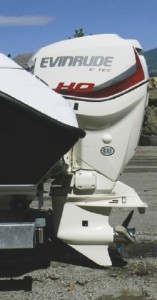
The 2014 Evinrude ETEC 90 is the very latest release from BRP and arrived just in time to be included in our shoot out. There is also an updated look over the entire Evinrude E-TEC engine line-up that includes new graphics and most importantly are based new graphite colour models.
The Evinrude E-TEC 90 H.O. weighs 177kg and has a 60-degree V4 powerhead which at 1726cc is one of the biggest engines in the 90hp shoot out and the only V4. Features of the new model include more low-end torque, a high output alternator, a multi-point oiling system and a 3-Star CARB clean emission rating.
According to BRP, the manufacturer, its Evinrude E-TEC direct injection 2-stroke outboard engines use 75% less oil than traditional two-strokes and 50% less than other direct injection systems. They are claimed to release only one-fifth of the carbon monoxide emissions of a four-stroke engine at idle and are compliant with stringent U.S. Environmental Protection Agency (EPA), European Union (EU), and California Air Resources Board (CARB) 3-Star ultra-low emissions standards.
The 90 H.O. also comes with a 5-year nondeclining warranty and 3 years or 300 hours with no dealer scheduled maintenance. It is available in three configurations – 20” white, 20” blue and 25” white. The 25” version has the same lower unit as E-TEC V6 outboards, with a 2.25:1 reduction ratio and takes the same propellers as the V6 E-TECs.
www.brp.com
HONDA BF90
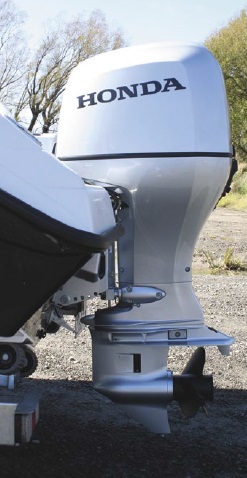
The BF90’s 1.5L, SOHC, 16-valve, in-line 4-cylinder VTEC engine is inspired by the same engine powering Honda’s top-selling Jazz automobile.
The BF90 features a high performance gear case with a low 2.33:1 gear ratio, coupled with Honda’s Boosted Low Speed Torque (BLAST) system that creates a strong holeshot while the exclusive Variable Valve Timing and Lift Electronic Control (VTEC) ensures top performance and fuel economy at all RPM levels.
The BF90 has a multi-port electronic fuel injection (EFI) fuel delivery system and coupled with a dynamic engine control module, the EFI delivers top fuel economy.
Utilizing an oxygen (O2) sensor, Honda’s exclusive Lean Burn Control system automatically adjusts the air/fuel mix according to speed and load.
With a first-of-its-kind 3-Way Cooling System, the BF90 reduces engine heat by allowing the cylinder head to run slightly cooler than the engine block, improving long-term durability.
www.hondamarine.co.nz
MERCURY 90
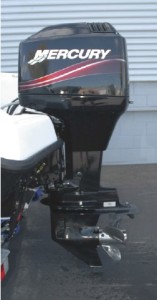
The Mercury 90 carburetted 2-stroke has the well-proven 1386cc three-cylinder block that has been around for some time and is also used for the Mercury 75hp engine. Available in 20” and 25” transom heights, the Mercury 90 is loop charged, with a built-in oil tank with top cowl access. A dipstick attached to the oil tank cap allows for easy checking of the oil level.
Features of the engine include single-point, variable-ratio oil injection, 18-amp alternator, CDI electronic ignition and a pressurized fuel enrichment system allows for easier starting in any troll position. At 137kg it is the heaviest of all the carburetted 2-strokes.
www.mercurymarine.co.nz
MERCURY 90 OPTIMAX
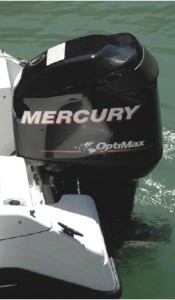
The in-line 3-cylinder Mercury 90 OptiMax is essentially one cylinder bank of an OptiMax 200 V6. The OptiMax injection system provides a constant supply of atomized fuel and air while the Vapour Separator Tank (VST) ensures a constant supply of liquid fuel for the injection process.
The OptiMax 90 is based on the same three cylinder, 1.5 litre block as the OptiMax 75, 115 and 125. All OptiMax engines feature direct fuel injection with the addition of a plume of compressed air, supplied from a belt-driven compressor, blown across the fuel spray to achieve very fine atomisation.
This technology was originally developed by Ralph Sarich’s company, Orbital Technologies, in Perth, Australia, and is licensed to Mercury Marine. It combines traditional two-stroke performance with very low fuel consumption, especially at medium and low engine speeds, when it is in stratified charge mode.
Via an electric pump, lubricating oil is injected directly where needed, resulting in fuel/oil ratios way below that of a comparable oil injected carburetted two-stroke outboard. As with its four-stroke EFI Mercury F90 counterpart, the OptiMax 90 has SmartCraft instrumentation displaying fuel flow, rangeto- empty, temperature, low lubricating oil and battery levels and other useful information.
www.mercurymarine.co.nz
MERCURY 90 EFI
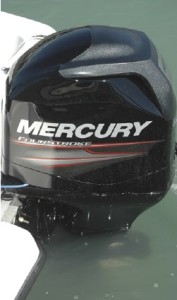
This 90hp 4-stroke EFI features the same valve train architecture as Verado. The basis of the engine is a four-in-line, 1732cc powerhead, – the largest displacement engine in the 90hp 4-stroke class – dual overhead cam engine that provides excellent low end power. It is also the heaviest of all the 90hp engines we tested, at 181kg.
Features include a 50-amp, 630-watt alternator, one of the most powerful in its class. This impressive alternator can power all your accessories – electronics, lights, livewells and audio equipment – throughout your trip. The 90 EFI comes standard with troll control – which allows you to set your engine speed as low as 650 rpm for trolling or running through extended no-wake zones – plus all of the other standard SmartCraft features
www.mercurymarine.co.nz
PARSUN T90
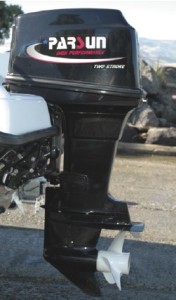
If you are looking for a seriously competitively priced 90hp engine then the Parsun T90 is for you. A basic carburetted 2-stroke, the Parsun T90 has a retail of around 60% less than the most expensive direct injection 2-stroke and at $7995 is claimed to be over $2500 less than the nearest carburetted 2-stroke equivalent.
Manufactured in China, by one of the world’s fastest growing outboard companies, the Parsun 90 is the largest engine in the Parsun 2-stroke range, which starts at 2hp. The 90hp offers an excellent power to weight ratio, being the lightest of all the engines tested at 115kg.
It has the same design of basic 1140cc 3-cylinder block as the Yamaha 90A. Most engine parts are also interchangeable between the two engines.
The engine runs a CDI ignition system, thermostat controlled water cooling system and has a vibration reduction system for smooth performance.
www.hurricaneproducts.co.nz
SUZUKI DF90

The first of Suzuki’s new generation of fourstrokes, the DF90A is a showcase of advancements and achievements – such as digital sequential electronic fuel injection, a 2.59:1 final drive ratio, ability to run a 14” diameter propeller, automatic starting, zero-maintenance, self-adjusting timing chain and Lean Burn Control System. New DF90A models also sport the optional Suzuki Troll Mode System, and the ability to interface into NMEA2000 compatible devices.
Designed to change the air/fuel mixture from 14:1 to 18:1 through the use of a lean burn system at medium and low speeds, this should provide fuel savings that are clear for everyone to see.
To quote the blurb in the DF90’s product information sheet, this is achieved through a reduction in fuel pumping loss. And in order to balance these efficiencies with clean emissions legislation, the system automatically sets up the air-to-fuel ratio to take advantage of the reaction characteristics of exhaust emissions.
At 155kg, the Suzuki DF90 is the lightest 90hp 4-stroke engine currently on the market. It is 8kg lighter than a Honda BF90, and 26kg lighter than a comparable Mercury 90EFI.
www.suzukimarine.co.nz
TOHATSU M90A

The M90A is unique in Tohatsu’s carburetted two-stroke outboard range, in that it is neither an up-rated or de-rated version of another engine with the same piston displacement.
The M90A -1267cc falls midway between the piston displacement of the 1140cc Yamaha 90A and the 1386cc Mercury 90. The Tohatsu M90A is 10 per cent heavier than the Yamaha but two per cent lighter than the Mercury. All these engines have three cylinders and three carburettors.
Being the first of Tohatsu’s three-cylinder outboards, the M90A has mechanical ignition timing advance and a solenoid-operated electric choke system, but all linkages are easily reached and adjusted if needed.
The M90A utilises Tohatsu’s “automixing” variable ratio oil injection system, where oil is injected at the fuel pump, ensuring it passes through the carburettors and lubricates the throttle butterfly valves.
www.tohatsu.co.nz
YAMAHA 90A
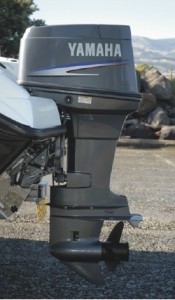
The Yamaha 90 carburetted 2-stroke is a three-cylinder engine based on the same block as the Yamaha 80 and is available in long or extra-long shaft. It is one of the lightest engines in the 90hp range.
The Yamaha 90A comes with Yamaha’s proven loop charging and pulse tuning to deliver excellent fuel economy and smooth, responsive acceleration. While in some parts of the world Yamaha sells a 4-stroke F90 outboard, in NZ, Yamaha markets the F90 as an F100, so the 2-stroke 90A is its only entry into the 90hp sector. The 4-cyl F90 is based on Yamaha’s latest 4-stroke technology, including a 16-valve engine with Double Overhead Camshaft (DOHC) for improved acceleration, advanced intake and exhaust system designs – and Yamaha’s unique multi-point EFI (Electronic Fuel Injection).
The 90A is oil injected with CD ignition and prime start auto choke system that automatically advances spark timing and chokes the engine for quick starts. Part of the package for the 90hp is an engine sensing warning system which electronically monitors the engine rpm and temperature to guard against engine damage.
www.yamaha-motor.co.nz
Summary
This shoot out is testament to the fact that the choice of propeller and the setting up of the outboard on the boat are absolutely crucial to getting the best performance out of your boat. This is almost as much a propeller and set-up shoot out as it is an engine shoot out!
It was to be expected that the 4-strokes would prove to have the lowest fuel consumption at cruising speeds, followed closely by the directinjected 2-strokes, with the old-technology carburetted 2-strokes the worst. However, that’s not entirely what the test data shows. The 4-strokes, as expected, were superior, but the data for the Tohatsu carburetted 2-stroke had it right up there with the 4-strokes for fuel economy, ahead of both of the direct-injected 2-strokes. Even more surprising was the data for the E-TEC direct-injected 2-stroke, which had it right down there with the bottom three carburetted 2-strokes. Our guess is that the propeller choice and set-up was not the optimum for this motor, but from the outset we made it clear to the engine suppliers that the choice of propeller and set-up were their responsibility.




